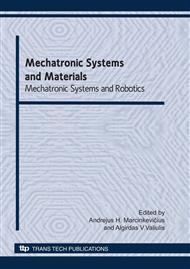p.239
p.243
p.249
p.255
p.260
p.265
p.271
p.278
p.285
Passive and Active Elements in Reduction of Vibrations of Torsional Systems
Abstract:
The adverse effects of vibrations on the performance of machines and their environment are the subject of various studies. That is why already in the machine design stage the designers have to face the problem of preventing undesirable effects in the functioning of new machines as well as adapting complete machines to the requirements resulting from the current knowledge on hazards caused by these machines. There are a number of methods for preventing excessive vibrations, which have an impact on machine sub-assemblies and elements. In particular, the passive, semi-active and active vibration-reducing systems can be distinguished [4,5].
Info:
Periodical:
Pages:
260-264
Citation:
Online since:
June 2010
Authors:
Keywords:
Price:
Сopyright:
© 2010 Trans Tech Publications Ltd. All Rights Reserved
Share:
Citation:


